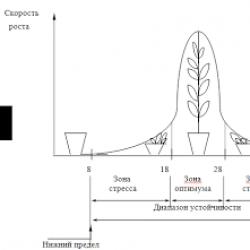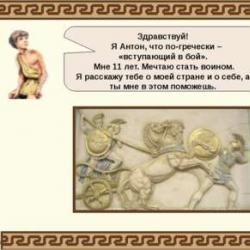A long German and a thick margarita are a sweet couple. Long Hermann in Tallinn What distinguishes Tallinn Long Hermann from all other towers is the presence of a bride
Toompea Castle(Toompea loss, address Lossi plats, 1a) was built on the hill of the same name by the Danes (the founders of the city, taani linn - “Danish city”) in the 13th - 14th centuries and since then has been the seat of local government, which has changed several times to this day: Upper The city was a vassal of the Danish kings, and of the Order of the Sword, and of the Livonian Order, which was replaced by the Poles and for several months Toompea was subordinate to the King of Poland. After the Poles there were the Swedes, until in 1710 the troops of Peter I entered Tallinn (then named Revel), after which Estonia became part of the Russian Empire for more than two hundred years.
The castle complex consists of three main parts: the western fortress wall with the “Long Hermann” tower belongs to the so-called “knightly” part; The administrative buildings of the castle were built during the Russian Empire - Catherine the Great ordered the construction of administrative buildings on the eastern side of the castle, which was done by 1773. The third main part of Toompea Castle is the Riigikogu - the Parliament of the Republic of Estonia; Its building, with its elegant pink façade, was erected in 1922 in the castle courtyard.
Additional information about the parliament can be found on the website www.riigikogu.ee (also in Russian).
Each new owner of Toompea Castle rebuilt it to suit his needs and tastes - for example, the Livonian Military-Religious Order (in which each knight took monastic vows) brought into the castle the architectural elements of a monastery and a fortified fortress similar to such crusader citadels as the famous giant Malbork Castle ( currently located in Poland). During the time of the knight-monks, Toompea Castle acquired premises characteristic of a monastery, and four powerful towers in the corners, whose names speak for themselves: Landskrone(Crown of the country), "Pilsticker"(Spear Grinder), "Stuer den Kerl"(Repel the enemy) and "Pikk Hermann"(Long Herman).
Toompea Castle and "Long Herman"
« Long Herman"(Pikk Hermann) is the tallest tower of Toompea Castle and the entire Upper Town, its height is 45.6 meters.

The name of the tower comes from the German Lange Hermann - “long warrior”; in those days this was the name given to the most powerful and well-fortified towers. “Long Herman” had 10 floors, the lower ones had barns, the middle ones had heated living rooms, and the upper rooms were intended for shooters and their weapons supplies. The tower is crowned by an open area.
Among all the towers, Long Hermann is the main symbol of power.
Tower "Long Herman" is the guardian of Toompea Castle. Ruthless time changed a lot in the appearance of Toompea, but could not crush the tallest of the castle towers - “Long Herman”.
Presumably, the tower is named after the hero of the German epic Lange Hermann, whose name translated from German means “Long Warrior”. Built in the 1360s, the Herman has stood guard over Tallinn like a soldier for centuries.
In the 16th century, another 10 meters were added to the considerable height of the tower.
On the first tier of “Long Herman” there was a barn. The upper tiers were occupied by heated living rooms and shooting rooms.
On the ground floor at a depth of 15 meters there was a dungeon. Prisoners were lowered into this prison through a small hole in the ceiling.
According to legend, death sentences were carried out here - the condemned man was thrown to the bottom of the shaft where the lions were kept, and the animals tore him into pieces. The prison was popularly nicknamed the “Lion Pit.”
Today, a staircase of 215 steps leads to the top of the modern “Herman”.
Every morning, simultaneously with the playing of the Estonian anthem, the national flag is raised over the Long Hermann tower, and in the evening it is lowered.
What distinguishes Tallinn's Long Hermann from all other towers is the presence of a bride.
There are many legends about “Fat Margarita” and “Long Herman”.
During the Middle Ages, a girl and a boy lived in Old Tallinn. The girl's name was Margarita, and the boy's name was Herman. Their love was tender and devoted, they knew no sorrows. Margarita was the daughter of a fisherman, she lived in the Fishing Village, she was a short girl, plump and smiling.
Herman lived on the opposite side of the city, he was tall and stately. They complemented each other perfectly. Margarita and German enjoyed every minute spent together. But according to city rules, they each had to go to their own home before midnight. Otherwise, misfortune will fall on their heads. One day this is exactly what happened.
In hot hugs and sweet kisses they forgot about time. With the first strikes of the clock on the City Hall, waking up from oblivion, they each rushed in their own direction, but it was too late... Both Margarita and Herman turned into stone.
Now everyone knows them: the towers Fat Margaret and Long Herman adorn Old Tallinn to this day.
The Great Sea Gate and the Fat Margaret Tower were built to protect the city from the sea, as well as to monitor ships arriving over the horizon. The Sea Gate, built at the same time as the city wall, is located in the northern part of the city in close proximity to the port. During the reconstruction of the gate in the 16th century, the battle tower “Fat Margaret” was built.
Today the tower houses the Estonian Maritime Museum, where an exhibition is held about the history of Estonian navigation and fishing. The observation decks on the roof offer a wonderful view of the Old Town and the Bay of Tallinn.
Who was Margarita, who gave her name to the tower, which was previously called the “Rosenkranz Tower”, that is, the “Rosary Tower”, and even earlier - simply the “Tower of the Rose Garden”, it will hardly ever be possible to find out.
And is it necessary? Urban folklore has long offered its own explanation: a story about the bride of a knight who went to war, who, in order to fight off obsessive suitors, went on a “bakery diet.”
She lost her attractiveness, but retained her loyalty to her chosen one: her morality was in a completely medieval spirit. Despite the fact that the whole story is the fantasy of local historians of the beginning of the last century.
Previous photo Next photo
In medieval Europe, Long Herman was the name given to a brave landsknecht, a desperate grunt and a conqueror of women's hearts. It is not without reason that the tallest tower of Toompea Castle, erected by the Knights of the Sword using the latest fortification technology on the edge of a 50-meter steep slope, received this nickname. Plus its own height is another 46 m, which allowed the patrols to scan the horizon in search of the enemy, being almost a hundred meters above sea level. The sooner they noticed enemy ships or troops, the more time they had to prepare to repel the attack.
History and legend
The first mention of the tower dates back to 1371. At different times, Danish, Swedish, Russian and Soviet standards flew on the Long Hermann. The Estonian flag was first raised over it in 1918 and again in 1989. Popular rumor connects Long Herman with another tower - Fat Margaret, standing near the port. They say that in reality they are two lovers, separated by an evil witch and turned to stone because of her envy and jealousy.
What to see
Tourists climb 215 wooden steps to the observation deck, from here a magnificent panorama of Tallinn and its surroundings opens. The black, white and blue flag of the Republic of Estonia flutters above their heads. The daily ceremony of his rise to the national anthem takes place at dawn, and his descent at sunset.
Under the tower, at a depth of 15 m, there are dungeons where criminals sentenced to death were kept. They were executed in the Lion's Pit, throwing unarmed people to hungry predators.
There, in the dungeon, there are stoves for heating the tower. They heated huge boulders, the heat from which spread throughout the residential and service areas on the floors through ventilation ducts.
Since the Long Hermann Tower is located on Parliament grounds, tours here are only possible in groups by appointment and with photo ID. But on April 23, the annual Open Day, free access is allowed for everyone.
One of the popular historical places in the city is the Long Hermann Tower. There are legends about its name; this name was owned by a warrior of Germanic legends; it was translated as “Long Warrior”. There is nothing surprising, because indeed the tower resembles an unyielding guard.
Tower "Long Hermann" - description
The Long Hermann Tower is not a single building, but one of the towers - a majestic structure in the central part of Tallinn, which stretches over 9 square meters. km. This building has a huge, centuries-old history; the “Long Herman” tower () became famous for being the highest elevation. The first mention of the tower dates back to 1371. With its powerful appearance, it looks like a defensive structure, because it was not without reason that the Danes built it to conquer Estonia. It was an observation platform, its height was 45.6 m, and above sea level it seemed even higher, since it was located on a steep cliff. From the top of the tower one could observe the sea and the dangers that were approaching from that side.

It had the following structure:
- On the first tier of “Long Herman” there was a barn.
- On the next tiers there was housing and training rooms.
- On the ground floor at a depth of 15 m there was a dungeon for prisoners. They were lowered down by rope, but there were legends among the people that the prisoners were eaten by lions that were constantly below.
- On the upper floors there were combat exits with viewing slits.
We walked around the tower using a staircase that was liftable. If the enemy got to the first floors, then the defenders moved up, while removing the stairs, and the capture of the tower was always suspended. Throughout the history of the tower, a flag fluttered at its top, which made it clear who currently owned the area. On the Long Hermann tower there were Danish, Swedish, Russian and Soviet flags. The flag of state Estonia appeared on the tower only on December 12, 1918, and then the period of Soviet power began, and the state flag in blue, white and black colors returned only at the beginning of 1989.

Tower "Long Herman" today
Today, the Estonian Parliament is located next to the Long Hermann Tower, and the national flag is constantly monitored. Its dimensions are 191 by 300 cm, and every day a minister rises to the top during sunrise and raises the flag.
The tower is inaccessible to visitors, with the exception of National Flag Day, when you can get to the very top. There are also tours of the Estonian Parliament, during which it is possible to get inside the tower. Not the entire Toompea castle has survived to this day; only the northern and western parts of the strong walls remain, as well as two towers - Landskrone and Pilshtiker.
Local residents say that the strength of the “Long Herman” depends on the strength of the “Fat Margaret” tower, which was his bride in the Middle Ages. There is a whole legend about this about a girl and a boy, between whom there was great love.
Among all the towers of the old city of Tallinn, “Long Herman” is a symbol of power, because even merciless time could not crush the tall building on which the flag flutters.
 How to get there?
How to get there? The Long Herman Tower is located in, there is no transport in this area. But you can get to it without much difficulty, it is within walking distance from the train station, you can walk there in 15 minutes. To do this, you will need to go to the right of the station, follow Nunne Street, and then along Pikk jalg. After passing, at the first intersection you need to turn left, then the road will go to the right. At the next intersection you need to turn right again, after which tourists will find themselves directly next to the tower.
2 333
Tower Long Herman
The pride of Tallinn
Among all the Estonian historical sights, the Long Hermann Tower stands out in particular. This is an ancient building that was erected in 1360. 100 years later it was rebuilt and enlarged. Currently, its height is almost 46 meters. This is a tower built on the mountain of the same name.

She has been guarding the city for many centuries and has more than once “rescued” soldiers in difficult times. There is an assumption that the tower got its name in honor of the German hero from the epic; his name translates as “Long Warrior”.
Impregnable tower
At the very top there is an observation deck, from where the guards watched the approach of the enemy, both from land and from the sea. And if he managed to break through the defenses, then this building served as a refuge for the guards. At that time, the upper floors were occupied by rooms that were heated during the cold season, as well as shooting rooms. But in the basement of the tower, at a depth of fifteen meters, there was a prison. Prisoners entered it through a narrow opening in the ceiling.

It is believed that death sentences were carried out in this place. The execution was a terrible reprisal of animals against the condemned. A person was lowered to the bottom of the dungeon in which the lions were kept, then the hungry animals tore the person who had offended the state into pieces. At that time the dungeon was called the Lion's Pit.
From the lower floors to the top of the tower it was possible to go by stairs. Therefore, if the enemy managed to break into the building, the guards made their way to the top through a narrow door and took the stairs. This stopped the enemy and did not give him the opportunity to advance deeper into the tower.

Today, to get to the very top of the building you need to climb 215 steps. Every day, the national flag is raised above the tower to the sounds of the anthem.

No less interesting places in Tallinn
I came on an excursion to the tower, it’s worth visiting it yourself, as well as praying in it, built in the 20th century. An interesting building is. This ancient building was built at the beginning of the 14th century. She received her strange name in honor of her captain.











